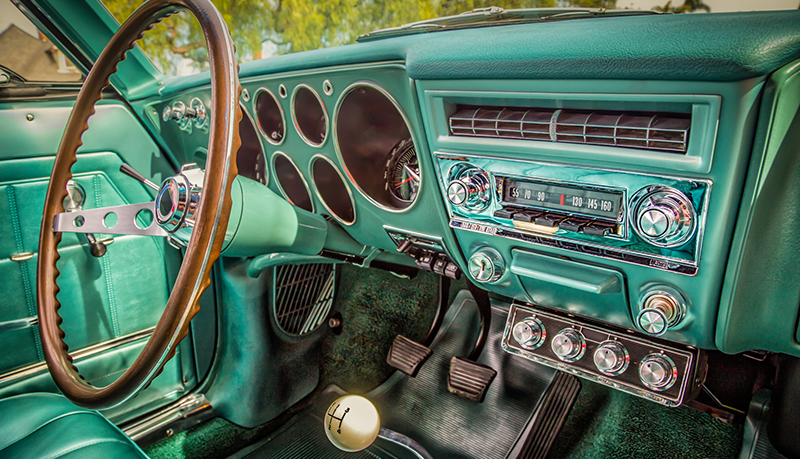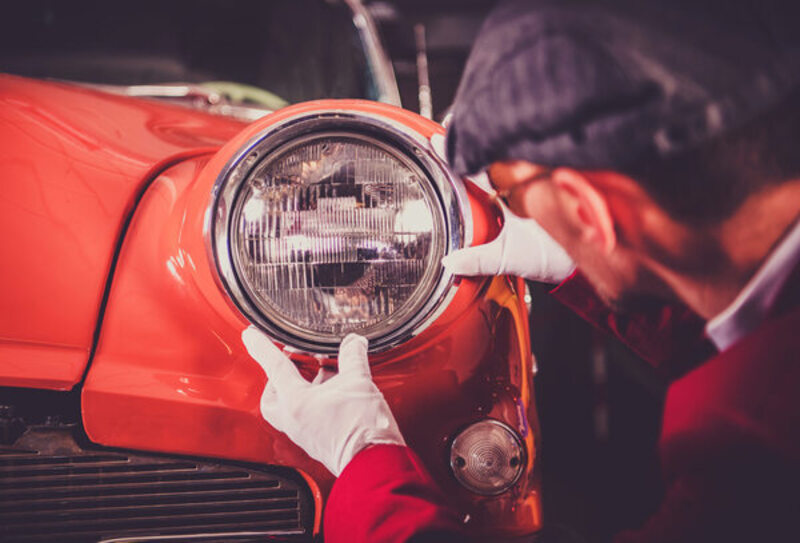Collectible Car
Driven by fellow automotive enthusiasts, our team appreciates the elemental beauty of a vehicle as well as the collector’s devotion to caring for it. We protect many of the most impressive automobile collections in the world, some larger than 500 cars. But even if you have just purchased your first classic roadster, our comprehensive approach is exactly the kind of unparalleled service you would expect from professionals who believe your passion need not take a backseat to security.



How we help
A unique investment deserves more than traditional automotive insurance. Collectible car coverage offers a broad spectrum of fine-tuned options from insurance carriers focused specifically on this market. Defining features include agreed and diminished value coverages, market appreciation, and unlimited roadside assistance, all of which allow for the most effective stewardship of these vehicles.
Our areas of expertise
We are renowned not only in the collectible car community, but in the private client sphere as well. As such, we are specially positioned to craft a full and creative suite of programs that protects all that matters to you: family, home, possessions, and pursuits.
Collectible vehicles
- Vintage/classic vehicles
- Vintage motorcycles
- Exotic vehicles
- Automobilia
- Restomod vehicles
Individuals and families
- High-end homes and estates
- Personal liability
- Daily automobiles
- Protection of trusts, LLCs and family limited partnerships
- Fine art, jewelry and collectibles
- Equine, farm and ranch
- Yachts and private aircraft
- Sports and entertainment
Related resources

In the driver’s seat: protecting your car at concours and auctions
Car collecting is a glorious passion, shared by a tight-knit community that happily stewards the world’s finest machines. There’s a special camaraderie with our car-collector clients, as we find them to be exceptionally passionate and engaged in their pursuit. Car collectors have a culture of sharing, with everyone quick to show off their vehicles, be it on a drive, or at auctions and showcasing their beautiful craftsmanship at events. In fact, many will tell you that there is nothing quite like being asked to exhibit on the field at Pebble Beach or Amelia Island. Of course, with any passion comes risk. So, whether it’s a slow parade of lovingly vintage roadsters or a local competition of restored muscle cars, we want to be sure your experience brings more pleasure than concern. To that end, here are our risk management best practices for taking your car to shows and auctions. To the Concours! First off, congratulations! To be recruited by a show’s selection committee is quite an honor, which speaks to the uniqueness or beauty of your automobile. But it is also one more reminder that you want to be doing everything in your power to ensure your investment is fully protected. That means you need to: Take care in transporting your vehicle. If you intend to use a third-party transporter, hire one with experience handling high-value collectibles. Even then, it is important to understand how much cargo coverage they carry on each truck. While some shippers offer upwards of $5 million, others offer none at all. And even $5 million may not be enough if a truck happens to be hauling $80 million worth of cars when an accident or other negligible event occurs. In any event, it is best to call your broker to confirm that you will be suitably protected. This check-in can be useful for another reason, too: One of our clients spent an extra $10,000 to insure the transport of his car to a rally in Israel, only to learn later that he already had global coverage in place. If you are moving a vehicle with a borrowed truck and trailer, know that whoever is doing the driving accepts responsibility for the car while it is in their custody and control. That person, then, needs to carry sufficient insurance—unless your policy stipulates that it will cover the bill should something happen. Regardless of how you choose to transport, take a video of the car before handing it off. Walk around the car completely to fully record its condition. (To protect their own interests, many professional transporters will do this as well.) Make sure your coverage will adequately protect your vehicle once it is at the show. The first priority is verifying that you have the proper liability in place for any potential mishap at the event. This is particularly important if your vehicle is either self-insured or not street legal, since you may not have liability protection should you cause bodily injury and/or property damage. This may be one of the rare times the vehicle will be driven around people— workers, spectators, and others at the show— and you want to make sure you are protected on the off chance something happens. Run a background check on any car handlers you intend to hire, including whether they are properly licensed and insured with acceptable driving records. If they are members of your full-time staff, consider this a chance to audit the insurance program that you have for them. It is worth asking your broker to review any waivers connected to the event to determine what organizers agree to cover, particularly in relation to security or weather-related issues. In most scenarios, the burden rests with the car owner, and we always want to have the opportunity to make sure you are properly covered in every case. Now, to auction! How exciting! If you are headed to auction, you have either made the decision to sell or are looking for a new purchase. Either way, ensuring that all goes smoothly requires a few specific steps: Again, make sure your vehicle is adequately covered for transport. The same best practices for getting to a Concours apply here. If you are hiring a professional, confirm that they have sufficient coverage or that your coverage will kick in should need be. If you are doing the moving yourself or entrusting the task to a friend, double check to see that the relevant insurance is in place. Follow all insurance requirements and best practices for the consignment period. Before your vehicle is accepted by the auction house, you will need to provide proof of liability that covers you and the car throughout the sale process. Generally, the consignment agreement states that the vehicle is your responsibility until the transfer. Though coverage responsibility falls to owners in most cases, there can be extenuating circumstances. At one auction in Scottsdale, 80-mph winds toppled an exhibition tent, causing significant damage to several of the cars sheltered underneath. The situation was litigated, for many years and the organizers were found liable. Still, it is always better to not have to rely on the legal system for reparations, so you want to make sure your best coverage is in place. Bring appropriate insurance documentation if you plan to make a purchase: Call your insurance broker in advance of the event to obtain proof of coverage, which is a requisite for bidding at most auction houses. Most insurance carriers provide coverage for new acquisitions for 30 days; however, our preferred carriers often extend to 90 days. We understand why car collectors want to showcase the beauty and craftsmanship of their automobiles and find the selling and buying that takes place at auction almost as exciting as participants do! But with a few precautions, you can spend the next sunny day on the open field or soaking in the energy of an auction, with less worry in sight. ...
More info
Fine art on the freeway: joys and risks of collecting classic cars
Pebble Beach. Quick what comes to mind? If it’s a slow parade of lovingly restored vintage race cars and roadsters driving along the dramatic Pacific coast cliffs—and not championship golf—then you’ve most certainly caught the classic car bug. Working with car collectors is a joy because they are exceptionally passionate about their pursuit. Our clients not only appreciate the beauty and craftsmanship of these automobiles, they also have a blast with their acquisitions—driving, racing and sharing the experience with the tight-knit community of equally engaged collectors. Whether you have a Bugatti or Bentley competing in the Concours d'Elegance or are contemplating which vehicle will start you down this road, we’re here to help make sure your classic car collection brings more pleasure than concern. Below, our team answers a few common questions around protecting an investment in classic cars. What do I need to worry about? Everything that concerns a regular car owner—accidents, breakdowns and theft— but multiplied by 10. A classic or vintage car is fragile, rare and valuable. In fact, sometimes it is irreplaceable so there are unique risks when owning a collectible like this. What are some of those risks? Well, classic cars are unique, which means the risk of theft or scam is higher. For example, after participating in a vintage car show, you will want to take necessary precautions to make sure your car gets safely put inside the garage and not in the hands of a thief. Another concern is market scams, which happen more often than you think. One client bought a vintage car on eBay only to discover that the purported “original” parts were decades younger than the rest of the car (meaning the parts were replaced…not refurbished as most collectors would want). To minimize these risks, we recommend to only buy from reputable dealers. In addition, have the vehicle appraised by an independent expert and demand proof you are buying from the rightful owner. If you need help securing the right vendor, your broker can provide you with a list of recommendations with deep expertise in the market. Should I actually drive my car(s)? Absolutely! That’s what makes collecting cars more fun than collecting stamps. But, be prepared for breakdowns—have a trusted towing service and knowledgeable mechanic lined up before you hit the road. And (buzzkill moment…) no personal automobile policies cover drag racing. So as tempting as it may be to reenact a scene from American Graffiti, a claim involving an accident will most likely be denied. How should I store my car(s)? We recommend you store it in a well-equipped garage with suitable alarms and security systems. Make sure the building protects against rain, ice, floods and whatever natural disasters are common in your area. That means if it’s in a separate structure on your property, it should conform to the same standards of your main residence—you may not want to situate it in a low-lying area or have a flat roof where snow can pile up all winter long. Even a slow leak or a few diligent mice can cause a lot of damage, so make sure someone checks on the car regularly if you can’t. Does my regular auto insurance cover my car(s)? Not really. You might buy coverage for your Lamborghini from the same company that insures the family Lexus, but the policies need different terms. Most important, the “settlement agreement” should treat the value of the car like a work of art that fluctuates with the market, because traditional insurance assumes a car gets less valuable every year. Whereas your car, most likely appreciates over time. With that said, you will also want enough coverage to recoup a loss that happens after the car appreciates. Similar to art, don’t forget to get it appraised every three to five years to keep the policy limits in line with the market. Do you recommend any other protections for my policy? We always recommend having a quick chat with your insurance broker. That will allow you to discuss the specifics surrounding your car(s). However to whet your appetite, here are two critical points worth noting as you pull out your policies. The policy should cover “diminution of value” of the car after an accident in addition to the repair costs. As we alluded to earlier, if that fender-bender means you need a new fender, the car is worth less than if it still had the original steel, even if there’s no difference to the untrained eye. You might want to consider “full transit coverage.” No, sadly this does not mean coverage when you ship your car cross country to participate in the Pebble Beach Car Rally. But rather, if you have a covered loss and need to transport your car for repairs, this coverage can be worthwhile. We may have just scratched the surface on your long list of questions, so set aside some time to speak with your broker. They are available to assist you with any concerns or additional questions surrounding that newly purchased classic car or the red beauty that is already a part of your collection. With a few precautions, you can spend the next sunny day on the open road, not a cloud or worry in sight. ...
More info
Steering clear of uninsured and underinsured motorists
It was a beautiful day and our client was enjoying an afternoon drive, windows down, elbow resting on the door. But in a moment delight turned to horror; her car was broadsided by another vehicle and rolled. She was successfully extracted from the wreckage, but the incident was not without major consequence. She had lost the use of her arm forever. Making matters worse, the motorist responsible for the crash was underinsured, leaving our client responsible for most of her costly and continuing medical expenses, lost wages, as well as the help she needed to care for her children as she healed. Unfortunately, this is an all-too-common occurrence. In 2022, one in seven drivers was uninsured, according to the Insurance Research Council—and that is before the pandemic wreaked its financial havoc. Recently, our claims advocates have noticed that more motorists than ever are significantly underinsured, with liability policies sufficient to cover only the smallest damages. At the same time, our roads have become more dangerous with 2020 being the worst year for U.S. traffic deaths in more than a decade. All of which explains why we are educating our clients about the importance of Uninsured and Underinsured Motorist (UM/UIM) coverage. This auto policy coverage component is as undervalued as it is vitally important to your financial peace of mind. How motorists end up with too-little insurance—or none at all—and why that could matter to you First, a little refresher: Typical automobile policies have many elements, to cover everything from vehicle damage (yours and others involved in an accident) to medical bills (yours and your passengers) to liability (the cost of harm, if you are at fault). The first two types of coverage are optional, but liability is mandatory in every state except New Hampshire. The amounts mandated, though, are often quite low; in any event, many motorists cancel those policies or cut them back even further once they have obtained their registration. There are two factors to blame for that: Tight wallets: Yes, the economy has rebounded well since the early days of the pandemic. Still, many bank accounts have not fully recovered from the virus’s significant financial hit. And when people need to save money, insurance is often one of the first cuts. Name-your-price insurance: Many drivers purchase policies online, without any expert guidance. With some carriers allowing people to decide what they want to pay, that can too often result in a purchase of the least-possible coverage. If an uninsured or underinsured driver causes an accident in which you are harmed, your automobile policy will not necessarily cover the totality of the costs, or even the majority of them. You can sue to recover your losses through the responsible party’s assets, but what if they have none? Any state mandated Uninsured and Underinsured Motorists coverage is not at all unlikely to make you whole either. A very worthwhile fix We encourage our clients to layer protections onto their auto insurance programs in order to maintain the highest levels of medical care and lifestyle security should a tragedy occur. We believe that though no one can predict accidents, everyone can effectively anticipate them. Consider another one of our clients who was standing on a sidewalk outside a car wash when she was hit by a car in a chain-reaction crash on the street. She spent the next four months in the hospital with a traumatic brain injury and continues to work with a neurologist and a therapist to recover. The two at-fault vehicles had liability coverage of $50,000 and $300,000, respectively—nowhere near enough to cover her ongoing expenses. But because she had added UM/UIM coverage to her auto and umbrella policies, she could rely on an extra $1.5 million to foot her bills. Here is the kind of policy inclusions we recommend to each of our clients: UM/UIM coverage: To provide financial assistance when you are in an accident with an at-fault driver who carries no liability insurance or whose liability limits are too low to cover the resulting damage or medical expenses. Excess UM/UIM coverage: To provide additional financial assistance to you or a family member beyond the maximum of your primary UM/UIM coverage. (Regular UIM coverage takes care of the amount beyond the at-fault driver’s policy limits, up to the UIM policy’s limits.) Simply put, acquiring these coverages means you never have to worry about another driver’s insurance choices. If the responsible party doesn’t have high enough limits to cover the necessary costs, your coverage will respond in place of that party, and your family and your assets will be properly protected. If you are unsure of whether you have the appropriate UM and UIM policies, please contact us for a quick review. ...
More info
How to keep minor accidents from becoming major problems
We’ve all been there—or probably will be at some point: The car in front of you comes to a sudden stop, too quickly for you to avoid knocking into it. No one’s hurt, thankfully, but their car is worse for the wear with a broken taillight and bent exhaust pipe. Your first reaction is to apologize and say “I’m sorry”. Knowing you were probably a little too close for comfort, you also say, “I’ll take care of it.” You’ve always heard that it’s better to handle small accidents yourself and avoid a potential increase in your auto insurance premiums. But what looks like a minor issue now could easily turn into a major problem later. You could get a call saying that the car’s entire exhaust system needs to be replaced because of the accident. Or you could be served with legal papers demanding damages because the driver suffered neck injuries. Such post-accident surprises are even more likely for affluent individuals, whose deep pockets will be suggested by the make and model of their car – and confirmed with a quick internet search. Flash forward: In court, a smart plaintiff’s lawyer portrays your well-meaning apology as an admission of fault. Even worse, if the accident wasn’t reported promptly to your insurer, the carrier may not cover your liability for damages or the cost of the lawyers to defend yourself. For example, a man who was in a minor accident, that he thought only caused a skinned knee, was recently sued for more than $50,000 in damages. He waited 21 months after the accident to report this seemingly minor collision to his insurance carrier. Not to mention, the court said the insurance policy required notice of every accident, no matter how small. To avoid any misunderstandings, not to mention unpleasant surprises, here is a simple-but-specific set of recommendations for anyone involved in a minor car accident. 1. Determine if anyone is hurt. If so seek the appropriate medical help immediately. 2. Don’t leave before exchanging information. First, because it’s a crime to leave an accident scene and second because the person you hit could later claim that you left without taking any responsibility. But the less revealing information you provide the better. So provide phone numbers instead of trading business cards, and give your personal email rather than one from work. 3. Be cautious with your wording. Even the most casual, “sorry” could be seen as an admission of fault by the courts. Even worse: “I wasn’t paying attention.” Instead, we recommend expressing your concern by asking, “Are you okay?” without commenting on your own actions. 4. Don’t volunteer to pay out of pocket. Even if that’s what you eventually decide to do, being eager to “just write a check” may signal more than wanting to avoid the hassle of filing a claim; it may tell the other party that money is not a big worry for you. A phrase like, “I’ll talk to my insurance agent and get back to you soon,” is all you need to or should say. 5. Consider calling the police. This may seem unnecessary, but a police report can prove valuable in he said/she said cases. This is especially important in a litigious place (like New York City) or if there is a question of who’s at fault, such as a sideswiping incident. 6. Photograph everything. We recommend photographing your car and their car along with the broader scene. Don’t forget to take a picture of their driver’s license, insurance card, registration and license plate. The more you can document the better. 7. Call your insurance broker or agent first. That is, before you call your insurance carrier. (Some carriers will cancel policies after a series of what they perceive as small claims.) Your broker can tell you what the next steps are given your circumstances. We might, for example, recommend that you write a check while notifying your carrier about the accident and explaining that no claim will be submitted. Doing this won’t guarantee your rates will stay the same, but a small increase might be more financially advantageous than having to pay a big lawsuit settlement. Likewise, an experienced broker can help make your best case to the carrier if there’s a risk of a rate increase. Whatever the circumstances of your next fender bender, your actions in the immediate aftermath of the incident can have significant financial and legal consequences. So before you jump to conclusions on how to handle what seems like a small collision, call your broker and get their advice on the next proper steps. A quick phone call can prevent a minor accident from turning into a major problem down the line. ...
More info
Alliant's leaders discuss the unprecedented insurance market
The insurance market is going through significant changes, many of which we have mentioned before: more difficulty in securing insurance, higher premiums nationwide, even non-renewals. But the situation continues to evolve, and there are early signs that the market will stabilize. To give you a clearer idea of where things stand and what the future may hold, two members of our leadership team share their thoughts. Is the current market as tough as everyone says? Cindy Zobian, EVP, Managing Director: Simply put, we have never seen market conditions like these before. In essence, it’s a capacity issue: the rate of natural disasters—and the damage caused by them—have increased exponentially while home values and rebuilding costs have gone sky high. Mark Recht, SVP: Case in point: we just got another announcement from a carrier about adjustments caused by inflation. Unfortunately, higher premiums and insurance challenges aren’t just happening to property owners in areas prone to most natural disasters, such as California and Florida. Those are countrywide phenomena. There is currently a cloud casted over the market. CZ: That said, we can see glimmers of light at the end of the tunnel! Well, that’s hopeful. What makes you optimistic about the future? MR: We saw a similar market a while back in Florida after Hurricane Andrew, but within a few years, things had shifted for the better. Homeowners learned to incorporate new and better risk-mitigation methods, the government placed stricter building codes, technology helped us to map the riskiest areas, and we incorporated more flexibility into insurance programs. Together, that all worked to stabilize the situation. As for the current moment, Cindy and I just met with reinsurers [Note: As a reminder, reinsurers assume a portion of carriers’ risks] and they told us they are in the process of figuring out how to add more capacity. If they can take on more risk, carriers will be able to as well. CZ: We have seen many insurance trends over the years, but, ultimately, they come down to finding a middle ground in the marketplace. That’s what the industry is striving for again today. I’m not saying the problems will be solved in a year, but our decades in the business have us hopeful that things will get easier eventually. At the same time, I don’t think insurance is going to be a buyer’s market again. What is Alliant Private Client doing to help policyholders in this market? CZ: We are being proactive. We don’t wait to get non-renewal notices or other surprises. Our team is constantly on the lookout for unexpected solutions to lost coverage. MR: For instance, clients are becoming more comfortable with unregulated solutions, so that has allowed us to be more creative in our use of non-admitted options. And without being arrogant, the fact that we are one of the largest brokers in the country gives us significant clout among carriers who have begun to prioritize trading partners. We are also working more with different organizations, and sometimes even direct writers, to be able to offer solutions that make things easier for our clients. And what can clients do to make things easier on themselves? MR: First and foremost, they need to recognize that it really is no longer a buyer’s market. These days, the priority is finding a suitable solution; pricing is secondary. Also, they should consider consolidating insurance solutions under one broker because carriers may, for example, be willing to take on your multi-million-dollar house in California’s brush territory if they are also insuring your less-expensive ranch in Idaho. You lose that benefit if you are dealing with multiple brokers. CZ: Also, when you get a bill, pay it on time. If you let your policy lapse, you might not be able to get it back. And be really thoughtful about making claims. Putting through even a $50,000 claim might hurt your premiums and renewal prospects. Be sure to discuss every potential claim with your broker first. Then they will help guide you on whether or not it’s in your best interest to put forth that claim. MR: And whenever you receive notice of a critical requirement—be it to trim brush or put in vents—follow through. Maybe you could ignore these in the past, but not anymore. Today, failure to comply might result in a policy cancellation. CZ: And lastly, of course, our clients should know that we are always here to help with questions and concerns about their risk management strategy. ...
More info
Protecting yourself in an ever more litigious world
Accidents happen. Even if you do everything to maintain a low profile— adhere to the speed limit, keep plenty of distance between you and your neighbors—there is still a rising chance that you will be the target of a costly lawsuit whether or not you are at fault. This is even truer for affluent individuals. To help you better understand the risks and mitigate any losses, we asked two of our Private Client team leaders, EVP and executive managing director, Cindy Zobian (CZ) and first vice president Steven Kent (SK), some frequently asked questions around personal liability in today’s ever litigious world. Why is it important to talk about personal liability? And why now? CZ: Simply put, people are more likely to sue one another today than ever before. Yet, we still see successful individuals and families who do not have enough personal liability coverage. These cases often involve auto accidents or injuries that occur on someone’s property, but claims can arise in nearly any situation. For example, a teenager who is accused of cyberbullying or a golfer who doesn’t yell “fore!” and then hits someone with a wayward shot. Expect their victims to sue, particularly if they perceive the other party to be affluent. SK: That’s true. I think it’s fairly common knowledge that affluent individuals are targets for lawsuits. However, you don’t have to be driving a Maserati to be targeted. There are so many ways for someone to conclude you are successful. Social media makes it easier for people to determine that you have money and would be worth the effort to sue. For example, if your profile has pictures of you standing in front of your Malibu mansion, you are more likely to get sued than if you’re standing outside a modest ranch. It’s important to be mindful of what you are posting publicly on social media. What if my lifestyle isn’t conspicuous? Will I need less liability protection? SK: Not necessarily. The affluent are more likely to live, work and play around people who own things that are costly to replace if damaged. CZ: Exactly. For instance, in one extreme case, a fire broke out in a client’s apartment in Manhattan. Their neighbors’ apartments were damaged. In fact, there was considerable smoke damage in one unit, which affected their neighbor’s priceless art and rare antiques collection. In addition to the damage, the residents expected to be put up in nice hotels while the repairs were being made. Our client’s insurance company ultimately paid tens of millions of dollars in claims. But most high-net-worth people are properly protected, right? SK: Excess personal liability insurance, often called “umbrella” policies, cover you against claims of injury to people and damage to property. Typically, your auto and homeowners’ policies have coverage included up to a certain limit. Umbrella policies provide additional protection over and above that limit. When we meet new clients it’s not that uncommon to find that they have very little or no umbrella coverage. That’s why it is so important to have a conversation about this. CZ: Accidents happen. For example, a few years ago, one of our clients had a relative visiting from out of town who borrowed his car. Unfortunately, the relative was not familiar with our roads and ran a stop sign, causing a bus to swerve onto an embankment and roll over. While there weren’t any passengers on the bus, there was a pedestrian riding a bike on the embankment who sustained serious injuries. This is an extremely unfortunate case but the bottom line is that while our client was not actually driving the car, he was still sued. How do these types of situations generally pan out? CZ: A few cases go to trial, but most are settled privately. We’re also seeing larger settlements regardless of who was at fault. We had a client hit a pedestrian who was texting while he was walking across the street. The driver, our client, had the right of way. Regardless, his insurance company ultimately paid out a six-figure settlement. Is there such a thing as too much liability coverage? CZ: We get this question a lot which is why we developed our proprietary tool, What’s My Liability. This tool calculates a suggested range of liability coverage. There’s no magic number to determine the correct amount because it really depends on the value of the assets that are being protected and the individual’s risk tolerance. We strongly suggest that you talk to a professional for further guidance. SK: For most of our clients, I’d say that if their limit is below $5 million, they are effectively uninsured. You can get coverage up to $50 million with little hassle. We do have a few clients who are in the public eye and are more concerned about being magnets for lawsuits. For reference, those clients carry more than $100 million in personal liability coverage. Any last thoughts? CZ: It’s easy to get this wrong, and the ramifications can be serious and expensive. So it’s always worth a 10 minute chat with a professional to make sure you and your family are properly protected. We’re here to help! ...
More info
Market update: why premiums and nonrenewals are rising
The insurance industry is in the midst of a correction due to a significant increase in catastrophic events such as hurricanes, wildfires, floods, and more. This has resulted in some clients facing challenges, ranging from higher rate hikes to non-renewals. Whether you have been directly affected or not, we want to educate you on the current market situation. To help you better understand what is happening, why it’s happening, and how you can mitigate its impact on your insurance program, we convened a group of senior leaders to answer frequently asked questions. However, before we go into the details, let’s take a step back and talk about insurance more broadly. Essentially, the market only functions because risks are pooled, and thus transferable. To cover one person’s home (or automobile or boat, etc.), carriers need to receive premiums from all their clients in an amount sufficient to offset their total exposure. The downside: Your rates are not just affected by your personal claim experience, but also by all those in the pool with you. Insurance can’t work if rates are only raised for people who’ve made claims. So even if you have a clean record with no claims, you could experience a renewal where your rates go up because you are in an area that overall has had large losses. The upside: While the ‘pooling’ of risk means you will be impacted by other people’s losses, it also means that in the event you have a major loss, you will likely be paid an amount that greatly supersedes the amount you’ve paid in premium over time. Say you pay an annual premium of $16,000 over the course of 20 years, then in year 21 lose a house that is insured for $4 million due to a fire, you have still come out ahead. Alright, now to the FAQs... Why is the market in this current state? Although it may feel personal, the market conditions are not a direct affront to individuals. Instead, two main factors are driving the changes. First and foremost, extreme weather events have been increasing across many parts of the country. Examples include the rising number of wildfires in the West, which have doubled in the past few decades. While California and the Gulf Coast are particularly affected, the Northeast and Midwest have also experienced their share of challenges. At the same time, major cities nationwide are also struggling with the effects of an increasingly crumbling infrastructure. Aging pipes in urban buildings have led to more costly water damage claims. For example, one of our carriers has paid nearly double this decade in water losses, and the number one reason is plumbing failures. Furthermore, the rising costs of repairs and reconstruction have compounded the challenges. The demand for skilled labor in the rebuilding process now surpasses supply, and replacing high-end appliances and amenities comes at a steep price. It’s important to note that suitable temporary living arrangements during such times are also costly. Ok, so how will this affect my premiums? Where once we considered anything more than 10% on the high side, we now regularly see jumps of 20%-25% a year. We encourage you to contact your Account Executive regarding your specific program and how your premiums may or may not be affected. Does the new reality impact me if I don't live in an at-risk area? Its possible. Keep in mind, while you may live in an area less prone to catastrophic events, that doesn’t mean you are exempt from severe losses. Hailstorms in Wyoming, tornadoes in Texas and severe winter storms along the East, have all been areas with damaging losses over the past few years. Therefore, no area is truly immune to loss. Even if one area within a region is not at risk of catastrophic loss, there may still be a raise in rates within that state. For example, premiums may go up on a townhouse in San Francisco because of wildfires in L.A. County. The reality is, the impact of these trends is nationwide. So, it is important to speak with your insurance broker as some markets are increasing their thresholds in certain areas and others are not writing any new business. Is there any relief in sight? It depends largely on science. If major weather incidents and the ensuing catastrophic losses continue or increase, carriers will then need to continue to adjust their exposure and rates accordingly. What can I do to help myself? To keep your premiums as low as possible, and your coverage intact, make your account look as appealing as possible to underwriters. That means sustaining small losses, utilizing higher deductibles and keeping your insurance available for catastrophic, worst-case events. This will also provide premium savings. For example, data suggests that properties with one water loss will likely realize another one soon—particularly in apartment buildings. If you put in a claim for a small water loss, you may be a riskier proposition to carriers. Therefore, taking care of small claims, could work in your favor when your policy comes up for renewal. We also encourage you to comply with all the recommendations suggested by your insurance carrier and to pay your premiums on time. Brokers can no longer guarantee reinstatement if you cancel for non-pay. Also, take the time to contact your broker and review all of your coverages. When acquiring new items or properties make sure you reach out to them to ensure you have the proper protection. If you still haven’t told them that you purchased a new car for your son months ago or you started investing in a wine collection – you should place a quick call and confirm coverage has been issued accordingly. Lastly, if you live in areas with serious weather concerns and have experienced a non-renewal or a drastic rate increase, ask your broker about secondary markets. They’re not ideal, and coverage terms may not be as broad as your existing policy, but they’re better than nothing. Anything else I should know right now? If you plan to follow our advice and only put in claims for major losses, select policies with high deductibles. You can also get breaks on premiums by complying with any safety measures prescribed by your carrier. Even if you don’t think you need a leak detector or backup generator, putting one in anyway will maximize the credits. Hey, whatever it takes! Always know we are here to guide you through this correction and any other insurance concerns as well. ...
More info
After teens drink, parents can pay
Anyone who has a teenager—or has been one—knows that kids usually try to end any conversation about the risks of drugs and alcohol as quickly as possible. But no matter how dismissive, it’s worth setting aside time for a serious talk about tort law. Although we aren’t here to give parenting advice, as insurance professionals, it is our responsibility to highlight and help our clients eliminate risks around even the most challenging or sensitive topics. So let’s address the topic head-on. We all know that when someone under the influence causes damage to a property or injures a person, the victim (or victim’s family) can sue for damages. But these days they also can—and do—bring suit against their drinking buddies, the host of the party, officers of the fraternity, and oftentimes against people’s parents. For example, a family could be exposed to a multi-million dollar claim if their son was president of a fraternity where someone drank too much. A Risk & Insurance article stated that “families are sued all the time for the acts of their students who are involved in incidents…where someone gets hurt”. The article even mentions that an “attorney is going to look for a compensation source, and if it’s mom and dad, then it’s mom and dad”. Not all of these suits are successful. Laws vary widely from state to state, and whether a person or their parents are liable depends on the circumstances. Still, most states have expanded liability for drug and alcohol-related incidents to encourage more people to intervene and prevent accidents from happening. So how can parents help mitigate these risks? Of course, emphasizing the harm – and risks – of alcohol and drugs is priority number one. But we often recommend that families discuss these points earlier, rather than later. • Don’t drink and drive or let anyone intoxicated drive. Create a family car service account, and promise your kids they can use it, no questions asked, when safety is in question. • Don’t give alcohol to anyone under the legal age. Your child and your family can be liable for any damage or injuries they cause. • Be wary of drinking games. A court might find your child encouraged someone to put themselves and others at risk. • Don’t let parties get too wild. Many states have “social host laws” that hold the entire family responsible for incidents involving people who consumed drugs or alcohol at their homes, even if they weren’t directly involved. • Be cautious lending the car. College students often share their cars with roommates. A friend’s accident could cause your auto insurance rates to skyrocket. • Check out the Greek organization before you rush. If your child joins one with a tradition of heavy drinking, know you might wind up in court over hazing. At Northern Illinois University, members of Pi Kappa Alpha and even some of their guests from a nearby sorority contributed to a $14 million settlement with the family of a student who died of alcohol poisoning at a party. What you can do to prevent a problem When they are at your home or using your car, you have the responsibility to make sure they are being safe and legal. If an accident does happen where your child is involved, you want to be able to prove that you were not negligent and took reasonable steps to prevent problems. • Patrol the parties. You’ll reduce your risk if you keep an eye on things to prevent underage drinking. If you can stay up past 10 PM, your biggest impact will be making sure that every guest that might be impaired takes an Uber home. Regardless, set clear rules for your kids. • Don’t let bad drivers take the wheel. Many states have a “family car” doctrine, that hold you responsible for any accidents caused by your kids, no matter the age. In any state, you are more vulnerable if you let your child keep driving after you get evidence that they are a risky driver and have speeding tickets and/or DWI violations. • If you give your child a car to use in college, consider putting it in their name. You may even want to do the same if you buy a condo for him/her to live in off campus. This may help insulate you from certain claims. But the protection isn’t absolute. How insurance can help cover your child’s actions Your existing homeowners, automobile and umbrella policies will likely cover your liabilities from most situations related to underage and college drinking, or drug use. Your policy will cover up to your limit of liability from bodily injury and property damage for you and your kids under 25 who live at home or are at college. If you aren’t sure you have the appropriate liability limit, jump on a quick call with your insurance broker who will be able to help. The benefit however, is short-lived. After the cost of these claims are covered relating to a drunken joyride or pre-game tailgate party, your insurance carrier may not renew your policies. You’ll discover that if you have a history of claims from these types of scenarios, buying new coverage can be quite expensive indeed. So, while it might be a challenging topic over Sunday dinner, addressing the ramifications head-on could be worthwhile for you and your family. Take a moment to call your insurance broker who will help you navigate the best ways to protect you and your family from these types of risks. ...
More infoMore specialty practices



